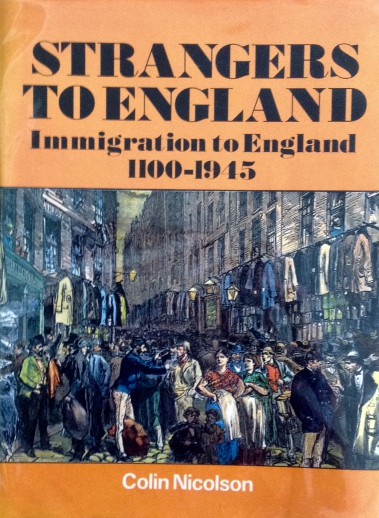Inspiring Older Readers
 posted on 11 Sep 2018
posted on 11 Sep 2018
Strangers to England: Immigration to England 1100 – 1945 by Colin Nicolson
One of the drawbacks to having a job in academia – especially in a subject like sociology – is that the books you tend to read or recommend to students aren’t necessarily the most visually beautiful or pictorially stimulating. In fact, you could easily get the impression that denser and duller a book is, the more it’s valued.
Just once in a while though you get the chance to break away from the tedious standard texts and dig into a bit of social history that allows you to broaden your book horizons. Preparing a lecture about immigration just recently set me off searching for information about immigrants into the UK prior to the Windrush generation. Colin Nicolson’s 1974 publication, Strangers To England: Immigration in England 1100 – 1945 popped up on one of my search engines and, checking it wasn’t already in the library, I decided to buy a copy.
This is a book that would be ignored by quite a lot of academics for a number of reasons: it has a popular audience in mind, it’s full of pictures, it isn’t weighed down by references to arcane theory and it’s too old to be ‘cutting edge’. These also happen to be primarily the reasons I love it.
It’s also published in an A4-sized hardback which allows the black and white prints plenty of space – and allowing for the fact that it covers a period when photography wasn’t available for the most part, it uses a range of diverse sources that are not often seen and that are truly fascinating.
What I especially like about the very straight-forward text is that it doesn’t try to be overly analytical but focusses instead on condensing, in a pretty intelligent way, historical information from some otherwise potentially indigestible sources. It’s also not trapped in the idea of immigration as an issue of ethnicity – there’s plenty here about the persecution and othering of Jews and other religious minorities who found their way to England. Ironically enough they chose England to escape oppression in their home countries only to find a slightly different but no less virulent prejudice also flourished in this country.
I increasingly find that the students I teach have the most tenuous grasp of history. There seems to be quite a popular view that if something happened before you were born or didn’t happen to someone in your family, it’s of no interest or, at least, isn’t something you need to know about. The current social strife that exists over the issue immigration is often popularly presented as if it were a new, contemporary problem. The recent cock-up over the status of immigrants coming from the West Indies in the 1940s and 1950s has created a sort of false public belief that this is when immigration to this country actually started but that is, of course, untrue. Books like Nicolson’s are vital to help provide an accessible, visually stimulating alternative record and they have the potential to get to an audience that detailed, academically rigorous tomes will never reach.
I also think that although the primary audience for this book is probably older students, there's a good chance that a reasonably strong and interested reader aged between 12-16 would also get a lot out of a book like this - it's certainly more lively than many you'll find and there's more information here that's accessible and detailed than you'll find on most history websites.
The book is, of course, out of print but you can get a copy second hand from on-line booksellers for not very much – there’s a paperback as well as a hardback available. I really shouldn’t put out of print books on my reading list but, what the hell, this one needs to be there.
Terry Potter
September 2018
(Click on any image below to view them in a slide show format)








